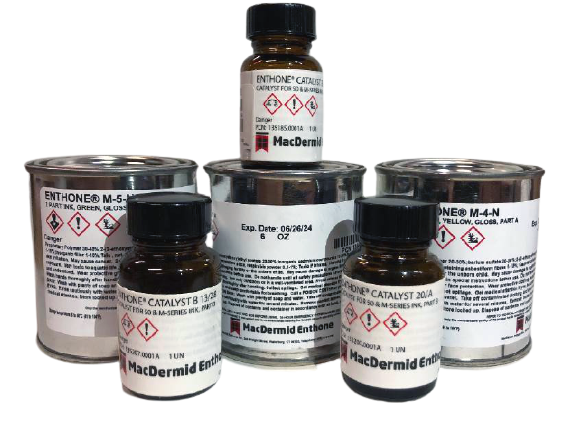MacDermid Enthone M-Series Permanent Marking Inks
M-Series inks are permanent, two component, epoxy-based marking inks.
They may be used with a selection of catalysts which cure at elevated and/or room
temperatures. When properly applied and cured, M-Series inks have excellent
adhesion to glass, metal and thermosetting plastics. They have excellent
chemical and thermal resistance properties.
Available Sizes: Bi-Paks (1/3 oz.), 6 Ounce Kits, 1 Quart Kits
COLORS
M 2 N Red (Cadmium)
M 3 N Orange (Cadmium)
M 4 N Yellow (Cadmium)
M 5 N Green (Cadmium)
M 6 N Blue
M 9 N White
M 0 N Black
M 0 NC Inorganic Black Non-Conductive
CATALYST
20/A: Basic air cure catalyst. Cures at room temperature in 5 to7 days. Tack free after 1 to 2 hours. May also be heat cured. R.T. or Heat Cure
B-3: Basic heat cure only catalyst. Higher cure temperatures decrease cure time. Heat Cure
5: Long pot life. Excellent adhesion properties. Special mix ratios are required for this heat cure only catalyst (refer toColor Numbers and Mix Ratios Section).
B-13/28: Accelerated air cure catalyst. Cures at room temperature in3 days. Shorter pot life. R.T. or Heat Cure
45: Long pot life. This heat cure only catalyst contains adhesion promoters. Provides excellent adhesion to glass and metals with good water resistance. Slightly decreases solvent resistance. Heat Cure
77: Adhesion promoting catalyst. Cures at room temperature in 5-7 days. Provides similar characteristics as Catalyst 45. Maximum adhesion is achieved by heat cure @ 65.6 to 93.3 C (150 to 200 F)
MacDermid Enthone Safety Data Sheets
Below are M-Series Safety Data Sheets
MacDermid Enthone Specifications
Below are approved Customer Ink Specifications for the defined Issuers
MacDermid Enthone Letters of Qualifications
Below are 2023 Letters of Qualification
Request Information
Methods of Application
Machine Marking
Minimum pressure is recommended for transfer-paid or flat-bed printers. Adjust rollers to 0.5 mils clearance prior
to the addition of ink. Increase the depth of the ink on the roll feeds until the ink is transferred. Additions of
AD2003 retarder may be used during the print run.
Hand Stamping
Use a brayer to roll out a thin film of ink onto a glass or metal plate. Transfer the ink from palate to the part with a
rubber, neoprene, or urethane stamp. Minimum pressure provides a shark image definition. Disposable stamp
pads made of finely textured polyurethane foam or foam rubber may also be used. Because the ink begins to
solidify at the end of its pot life, stamp pads cannot be reused.
Screen Printing
Monofilament polyester fabrics with a mesh count of 180-330 may be used. Mesh tension should be to the fabric
manufacturer’s recommendations. Stencils may be applied by, indirect, or direct/indirect methods. Squeegee
material should 70-80 durometer, sharp and free of nicks. Squeegee durometer, pressure, angle, and print speed
should be adjusted according to overall printing parameters to ensure high quality print definition.
Spraying
Following the induction period, think with AD2002 or a blend of 80% PM glycol ether and 20% methyl isobutyl
ketone at 25-40% by volume, depending on the air pressure and orifice of spray unit. Thinner additions will extend
the pot life considerably


